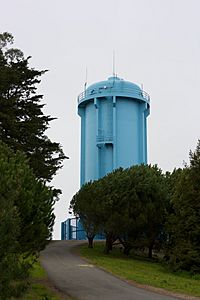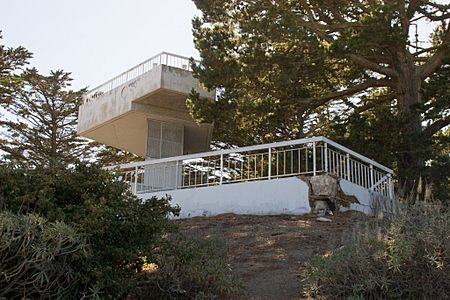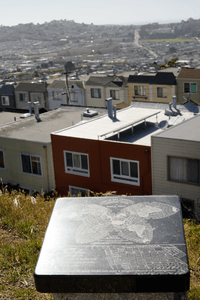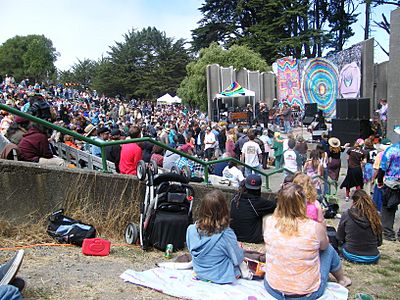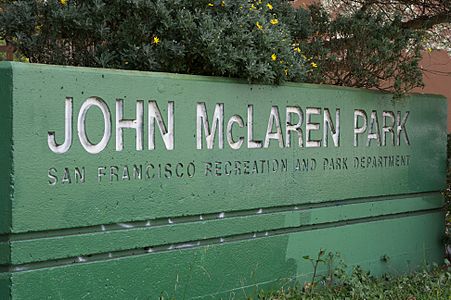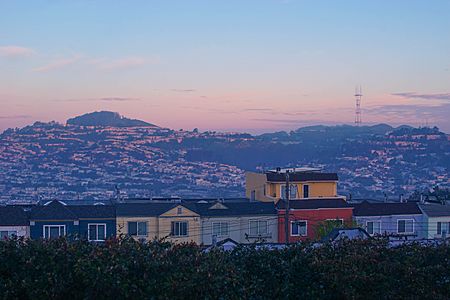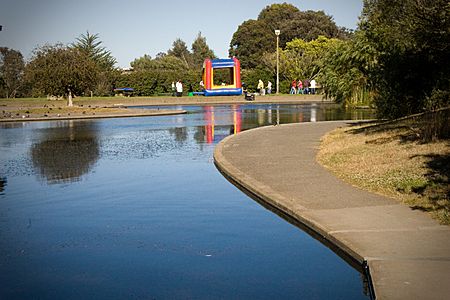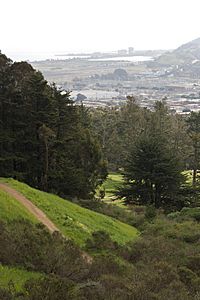John McLaren Park facts for kids
Quick facts for kids John McLaren Park |
|
|---|---|
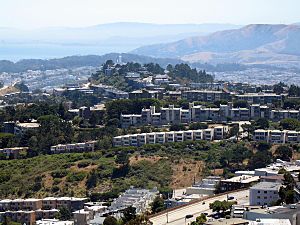
The prominent east-west ridge of McLaren Park, viewed from the Excelsior District, topped with the blue La Grande Tank. San Bruno Mountain is in the background.
|
|
| Lua error in Module:Location_map at line 420: attempt to index field 'wikibase' (a nil value). | |
| Type | Municipal (San Francisco) |
| Location | San Francisco |
| Area | 313 acres (1.27 km2; 0.489 sq mi) |
| Created | 1926 |
| Status | Open all year, 5 A.M. to midnight (Restrooms open 8 A.M. to 5:30 P.M.) |
| Public transit access | |
John McLaren Park is a big park in southeastern San Francisco. It's about 312.54 acres (126.48 ha) in size. This makes it the third largest park in San Francisco. Only Golden Gate Park and the Presidio are bigger. The park is surrounded by several neighborhoods. These include Excelsior, Crocker-Amazon, Visitacion Valley, Portola, and University Mound.
Contents
History of John McLaren Park
John McLaren Park was once part of a huge land area. This land was called Rancho Cañada de Guadalupe la Visitación y Rodeo Viejo. It was granted in 1840 by the governor of Mexico. This grant included much of what is now San Bruno Mountain and the city of Brisbane.
How the Park Was Planned
In 1905, a city planner named Daniel Burnham suggested a big plan for San Francisco. He thought the southern part of the city needed more parks. He suggested that the land where McLaren Park is now should be saved for a park. He even named one part "University Mound Park."
After the big earthquake and fire in 1906, the city rebuilt quickly. They didn't follow Burnham's park plan right away.
Creating the Park
On October 4, 1926, city leaders decided to buy 550 acres (220 ha) for a new park. They first planned to call it "Mission Park." But on November 29, 1926, they renamed it. They chose to honor John McLaren. He was a very important park superintendent.
McLaren himself celebrated the park's dedication in 1927. Boy Scouts helped plant redwood trees. The wife of a famous plant expert, Luther Burbank, also gave walnut trees. These were the first trees planted in the park.
Park Size Changes Over Time
The city wanted to buy all 550 acres (220 ha) for the park. But a plan to raise money in 1928 didn't pass. So, the park ended up being smaller than first planned. From 1928 to 1946, the city bought land for the park bit by bit.
By 1944, the park was about 222 acres (90 ha). Some of the original planned park land was used for other buildings. These included schools and homes for elderly women.
Building the Park Features
In the 1930s, the Works Progress Administration helped build a scenic road. This road is still part of the park today. The park also used to have horse trails. But these were later removed.
The park grew to its current size of 318 acres (129 ha) in 1946 and 1958. Many playgrounds, the golf course, and hiking trails were added later. This happened between 1950 and 1980.
Amenities and Features of McLaren Park
McLaren Park has many cool places to visit. Coffman Pool was the first recreation spot. It was built in 1958. A plan in 1959 suggested even more fun things. These included a golf course, picnic areas, and trails.
Many of these ideas were built in the 1960s. This included the Gleneagles Golf Course and McNab Lake. Playgrounds like Louis Sutter, Herz, and Mansfield-Burrows were also added. New trails and picnic spots were built too.
The park is known for its hills. San Francisco is a hilly city, and McLaren Park is one of the hilliest spots. This makes for great views and challenging walks!
Gleneagles Golf Course
The 9-hole golf course was finished in 1961. It covers about 60 acres (24 ha) of the park. You can play a round of golf here.
Herz Playground
Herz Playground is a fun spot for kids. It's located near Coffman Pool. This playground was completed in 1965.
Jerry Garcia Amphitheatre
The park has a large outdoor amphitheatre. It was built in 1970 and opened in 1971. It has great sound for shows. In 2005, it was renamed the Jerry Garcia Amphitheatre.
This was done to honor Jerry Garcia. He was a famous musician from the band Grateful Dead. He grew up very close to the park. Every year, there's a "Jerry Day" celebration here. It's a fun concert with birthday cake and ice cream.
La Grande Tank
The La Grande Tank is a very noticeable blue water tank. It's 80 feet (24 m) tall. You can see it from far away. It was built in 1956.
Louis Sutter Playground
Louis Sutter Playground is another playground in the park. It's near McNab Lake. This playground was finished in 1965.
Mansell Street
Mansell Street is a road that goes through the park. It used to be a wide, four-lane road. It was planned to be part of a bigger highway. But that highway was never fully built.
Now, Mansell Street is a two-lane road. One side is a special path for walking and biking. This makes it safer and easier to get around the park.
Mansfield-Burrows Playground
Mansfield-Burrows Playground is in the northwestern part of the park. It was added in 1978.
Philosopher's Way
Philosopher's Way is a special trail. It's a 2.7-mile (4.3 km) loop around the edge of the park. It opened in 2013.
Along the trail, there are fourteen stone markers. These are called "musing stations." They are meant to make you think and enjoy the views. On a clear day, you can see amazing sights. These include Mount Diablo, Mount Tamalpais, Angel Island, and the Pacific Ocean.
Wilde Reservoir Overlook
The Wilde Reservoir Overlook is on the eastern side of the park. It opened in 1981. It used to be a water storage area. Now, its old walls are a viewing platform. There's also a tall tower, but it's been closed to the public since the late 1990s.
Yosemite Marsh
In the northeast part of the park, you'll find Yosemite Marsh. This is a special place for local plants and animals. It's home to creatures like the forktail damselfly. The marsh is also where Yosemite Creek begins. This creek flows underground towards Candlestick Point.
Gallery
-
View west to the Excelsior from La Grande Tank, with a "musing stone" from Philosopher's Way in the foreground.
-
View down to McNab Lake and Louis Sutter Playground, with Sutro Tower in the background.
Images for kids



